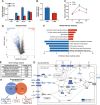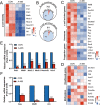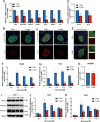CBP/p300 HAT maintains the gene network critical for β cell identity and functional maturity
- PMID: 33980820
- PMCID: PMC8116341
- DOI: 10.1038/s41419-021-03761-1
CBP/p300 HAT maintains the gene network critical for β cell identity and functional maturity
Abstract
Loss of β cell identity and functional immaturity are thought to be involved in β cell failure in type 2 diabetes. CREB-binding protein (CBP) and its paralogue p300 act as multifunctional transcriptional co-activators and histone acetyltransferases (HAT) with extensive biological functions. However, whether the regulatory role of CBP/p300 in islet β cell function depends on the HAT activity remains uncertain. In this current study, A-485, a selective inhibitor of CBP/p300 HAT activity, greatly impaired glucose-stimulated insulin secretion from rat islets in vitro and in vivo. RNA-sequencing analysis showed a comprehensive downregulation of β cell and α cell identity genes in A-485-treated islets, without upregulation of dedifferentiation markers and derepression of disallowed genes. A-485 treatment decreased the expressions of genes involved in glucose sensing, not in glycolysis, tricarboxylic acid cycle, and oxidative phosphorylation. In the islets of prediabetic db/db mice, CBP/p300 displayed a significant decrease with key genes for β cell function. The deacetylation of histone H3K27 as well as the transcription factors Hnf1α and Foxo1 was involved in CBP/p300 HAT inactivation-repressed expressions of β cell identity and functional genes. These findings highlight the dominant role of CBP/p300 HAT in the maintenance of β cell identity by governing transcription network.
Conflict of interest statement
The authors declare no competing interests.
Figures







Similar articles
-
Acetyltransferases CBP/p300 Control Transcriptional Switch of β-Catenin and Stat1 Promoting Osteoblast Differentiation.J Bone Miner Res. 2023 Dec;38(12):1885-1899. doi: 10.1002/jbmr.4925. Epub 2023 Nov 7. J Bone Miner Res. 2023. PMID: 37850815
-
E2A proteins enhance the histone acetyltransferase activity of the transcriptional co-activators CBP and p300.Biochim Biophys Acta. 2012 May;1819(5):446-53. doi: 10.1016/j.bbagrm.2012.02.009. Epub 2012 Feb 22. Biochim Biophys Acta. 2012. PMID: 22387215
-
Valproic acid exposure decreases Cbp/p300 protein expression and histone acetyltransferase activity in P19 cells.Toxicol Appl Pharmacol. 2016 Sep 1;306:69-78. doi: 10.1016/j.taap.2016.07.001. Epub 2016 Jul 2. Toxicol Appl Pharmacol. 2016. PMID: 27381264
-
Current development of CBP/p300 inhibitors in the last decade.Eur J Med Chem. 2021 Jan 1;209:112861. doi: 10.1016/j.ejmech.2020.112861. Epub 2020 Oct 1. Eur J Med Chem. 2021. PMID: 33045661 Review.
-
Recent Advances in the Development of CBP/p300 Bromodomain Inhibitors.Curr Med Chem. 2020;27(33):5583-5598. doi: 10.2174/0929867326666190731141055. Curr Med Chem. 2020. PMID: 31364510 Review.
Cited by
-
Transcriptional co-activators: emerging roles in signaling pathways and potential therapeutic targets for diseases.Signal Transduct Target Ther. 2023 Nov 13;8(1):427. doi: 10.1038/s41392-023-01651-w. Signal Transduct Target Ther. 2023. PMID: 37953273 Free PMC article. Review.
-
Porcine Deltacoronavirus Infection Cleaves HDAC2 to Attenuate Its Antiviral Activity.J Virol. 2022 Aug 24;96(16):e0102722. doi: 10.1128/jvi.01027-22. Epub 2022 Aug 2. J Virol. 2022. PMID: 35916536 Free PMC article.
-
KATs off: Biomedical insights from lysine acetyltransferase inhibitors.Curr Opin Chem Biol. 2023 Feb;72:102255. doi: 10.1016/j.cbpa.2022.102255. Epub 2022 Dec 28. Curr Opin Chem Biol. 2023. PMID: 36584580 Free PMC article. Review.
-
Streamlined quantitative analysis of histone modification abundance at nucleosome-scale resolution with siQ-ChIP version 2.0.Sci Rep. 2023 May 9;13(1):7508. doi: 10.1038/s41598-023-34430-2. Sci Rep. 2023. PMID: 37160995 Free PMC article.
-
A-485 alleviates postmenopausal osteoporosis by activating GLUD1 deacetylation through the SENP1-Sirt3 signal pathway.J Orthop Surg Res. 2025 May 29;20(1):542. doi: 10.1186/s13018-025-05839-4. J Orthop Surg Res. 2025. PMID: 40442713 Free PMC article.
References
Publication types
MeSH terms
Substances
LinkOut - more resources
Full Text Sources
Other Literature Sources
Molecular Biology Databases
Research Materials
Miscellaneous

